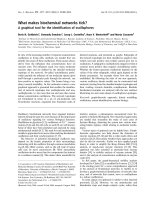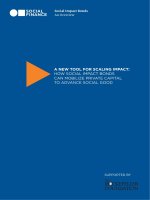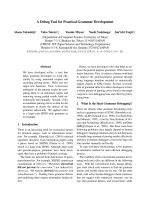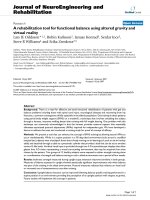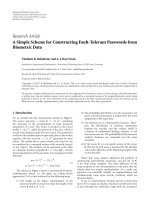A simple tool for infection prevention and control practice surveillance: Development and use for designing feasible programs in E gyptian hospitals
Bạn đang xem bản rút gọn của tài liệu. Xem và tải ngay bản đầy đủ của tài liệu tại đây (241.59 KB, 10 trang )
Int.J.Curr.Microbiol.App.Sci (2019) 8(3): 453-462
International Journal of Current Microbiology and Applied Sciences
ISSN: 2319-7706 Volume 8 Number 03 (2019)
Journal homepage:
Original Research Article
/>
A Simple Tool for Infection Prevention and Control
Practice Surveillance: Development and use for Designing
Feasible Programs in Egyptian Hospitals
Fatma Abdelaziz Amer1*, Ahmed Ashraf Wegdan2 and Heba AliMohtady1,3
1
Medical Microbiology and Immunology Department, Zagazig Faculty of Medicine,
Zagazig, Egypt
2
Medical Microbiology and Immunology Department, Elfayoum
Faculty of Medicine, Elfayoum, Egypt
3
Fakeeh College for Medical Sciences, Kingdom of Saudi Arabia
*Corresponding author
ABSTRACT
Keywords
Infection prevention
and control, Egypt,
Practice
surveillance,
Check-list,
Surveillance tool,
Middle- income
countries, Lowresource setting
Article Info
Accepted:
07 February 2019
Available Online:
10 March 2019
In developing countries, it may be difficult to survey for nosocomial infections (NI).
Moreover, a structure- based rather than internationally recommended infection prevention
and control (IPC) programs are more applicable. IPC practice surveillance could be an
additional or substituent survey. The current work describes the development of a
measurable and updated tool for surveillance of IPC practices which we called “Ranked
IPC Audit Check- Lists (RIPCACL)” and to evaluate their use for tailoring IPC programs
in two hospitals in Egypt. The development addressed; first IPC procedures and second the
needed resources. The check- lists were rendered measurable through a simple scoring
system. They were used twice in two university hospitals. The first time was to capture a
base- line IPC practice level, so IPC programs were tailored. The second was for
monitoring and evaluation. The first implementation determined the practice levels in the
two hospitals and identified the problematic areas. Further analyses of individual check list
revealed the exact causes of trifling levels. Two IPC programs were tailored and
implemented. Second implementation identified areas that could be upgraded and those
which remained in a need for interventions. RIPCACL were convenient, flexible and
easily applicable. They can be used in similar settings.
implement, monitor and evaluate IPC
interventions, Pittet (2005). Surveillance of
NI has been the gold standard for IPC
programs. In developing countries and in lowresources settings, studies have shown that
this surveillance is challenging, particularly at
early stages of IPC implementation
Introduction
IPC programs are essential for providing
appropriate healthcare service and for
promoting patient safety. Surveillance is the
initial logical step of an IPC program.
Surveillance data is needed to create,
453
Int.J.Curr.Microbiol.App.Sci (2019) 8(3): 453-462
(Mahomed et al., 2017; Alp et al., 2011).
Healthcare organizations may choose to
include other surveillance to replace or
supplement NI surveillance.
So, there is now a need to upgrade and update
our previously developed RICACL and then
to assess their value for designing appropriate
IPC programs.
IPC practice surveillance which determines
compliance with IPC measures can be an
acceptable choice, Amer (2017). At the core
of this surveillance approach is the checklist
which is an elegant and simple tool.
Checklists have been a big part of the
significant success in the battle against NI
(Abraham and Schwab, 2004; World Alliance
for Patient Safety, 2018; the Joint
Commission in collaboration with other
international organizations, 2018). Nowadays,
checklist protocols are provided by reputable
international organizations, and postimplementation reports are available,
predominantly, from industrialized countries.
The checklists have proven to work best in
establishments with high resources, supported
by leaders who prioritize safety in daily care
routines, Parand (2014). Because the situation
is different in low- resource settings, the
internationally- released checklists need to be
modified (Amer et al., 1997a). An important
novelty is to render them measurable, so the
baseline situation, monitoring and evaluation
statuses are translated into figures (Amer et
al., 1997b) which support valid comparative
analyses. Two decades ago, we successfully
developed and implemented a simple tool
which we called “Ranked Infection Control
Audit Check- Lists (RICACL)” to design IC
programs for the Cost Recovery for Health
Project, in a pilot of 5 facilities in Egypt,
Hassan (2008). In the early 2000s, at the
request of John Snow Incorporation (JSI) and
in partnership with the Egyptian Ministry of
Health and Population, these checklists were
adapted, upgraded and used successfully to
design and implement IC program in a diverse
set of facilities in Upper Egypt, John Snow
Incorporation (2018). Currently, in 2018 great
progress has been achieved in the area of IPC.
The current work describes the innovation
process of the RICACL and their
implementation for tailoring applicable IPC
programs in two university hospitals in Egypt;
Zagazig and El-Fayoum University Hospitals
Materials and Methods
RICACL for IPC practice surveillance were
translated to the native language (Arabic).
The updating process addressed two
components. The first was the IPC procedures
consistent with implementation of IPC
program and the second was the resources
required to carry-out the IPC procedures. To
cope with the new terminology, RICACL has
been termed Ranked Infection Prevention and
Control Audit Check- Lists (RIPCRCLs).
The IPC procedures included both basics
(handwashing,
cleaning,
disinfection,
sterilization and isolation precautions) as well
as departmental procedures for operation
room (OR), intensive care unit (ICU),
neonatal intensive care unit (NICU),
hemodialysis unit (HU), laboratory (Lab),
radiology department (RD), physiotherapy
department (PD), laundry department (LD),
dietary department (DD) and maintenance and
engineering department (M/ED). Each
checklist consisted of several core sections
under which a series of relevant IPC elements
were enumerated. The sections and elements
were developed after reviewing and adapting
a number of recently published guidelines
such as CDC, World Health Organization
(WHO) and others whenever possible.
Resources
section
encompassed
all
requirements of an effective, integrated IPC
program across the healthcare continuum.
454
Int.J.Curr.Microbiol.App.Sci (2019) 8(3): 453-462
They included: 1) human resources factors,
i.e. training, staffing ratio in various services
and departments and occupational health, 2)
infrastructures elements including building
environment, architectural designs, ventilation
systems,
number
of
handwashing
facilities/hospital
area
and
hospital
incinerator, 3) equipment-related items
including medical devices, smart accessories,
bedside mobile monitors and others, existence
of maintenance service and software
packages, and 4) direct patient care factors,
including bed occupancy, consumables and
disposables, personal protective equipment,
signs and taps of isolation, linen and
bedclothes and decontamination equipment.
the infection control team (ICT) and the
second was for all the healthcare workers
(HCW).
Check- lists were implemented twice. The
first time was to capture a base- line IPC
practice level and to determine area of
problems. ICC members had access to
collected data that supported tailoring IPC
programs and subsequent implementation.
The second implementation of the check- lists
was after 6 months for monitoring and
evaluation.
Findings
A compilation of 15 “RIPCACLs” were
finalized for use in each hospital. The hand
washing check- list contained 30 IPC/resource
elements and was given 20% of the total
score. Other check- lists; cleaning,
disinfection,
sterilization,
isolation
precautions, OR, ICU, NICU, HU, Lab, RD,
PD, LD, DD and M/ED contained the
following IPC/resource elements and were
given the percentage score shown between
brackets; 73 (10%), 60 (10%), 70 (10%), 60
(10%), 45 (5%), 30 (5%), 30 (5%), 50 (5%),
50 (5%), 30 (3%), 20 (2%), 40 (4%), 40 (4%),
20 (2%), respectively.
The scoring system used before (11), was
utilized: 1) the score of an individual checklist
was 100% distributed among core and the
resource sections, 2) a positive “yes” (coded
as 1) for each IPC/resource element indicated
implementation/existence of that element. All
other findings (“no”, “not sure” or
“sometimes”) were coded as zero (Table 1).
The grades of each IPC practice measured by
an individual check- list or the grades of
practice of the whole facility measured by all
check- lists are converted into percentage
score for each list or for the whole facility by
simple mathematical calculation. Results were
presented as tables or graphs to allow easy
visual interpretation and comparison.
The first use of the “RIPCACLs” identified an
acceptable overall IPC practice score of
386/648 (60%) in Zagazig University
hospital. Detailed analysis of individual
practices revealed the followings to be areas
for improvements; hand washing (10/30,
33.3%), isolation precautions (20/60, 33.3%),
RD (10/30, 33.3%), PD (5/20, 25%), LD
(10/40, 25%), DD (10/40, 25%) and M/ED
(5/20, 25%). HU and Lab scored at the low
acceptable levels (60%, 52% respectively).
Other levels had a good score; cleaning; 82%disinfection; 83%- sterilization; 86%- OR;
88%- ICU; 84%- NICU; 84%.
Check- lists were then reviewed by the
infection control committee (ICC) of the two
hospitals to evaluate their comprehensibility
and to ensure accordance with services
provided, patient population and environment
with modification being made accordingly.
Consistent with ICC’s recommendations, the
key measure or resource section scoring less
than 50% was considered a problematic area.
Two (one- day) orientation workshops were
carried out in each facility; the first was for
455
Int.J.Curr.Microbiol.App.Sci (2019) 8(3): 453-462
In Elfayoum university hospitals, the first
implementation of all check- lists identified
acceptable overall IPC practice score of
354/648 (55%). Detailed analysis of
individual practices revealed the same areas
identified in Zagazig University hospital to be
areas for improvements (hand washing
(10/30, 33.3%), isolation precautions (20/60,
3.3%), RD (7/30, 23.3%), PD (3/20, 15%),
LD (10/40, 25%), DD (10/40, 25%) and
maintenance/engineering department (3/20,
15%) in addition to the lab; 23/50, 46%. HU
scored at the low acceptable levels (25/50,
50%). Other levels had a good score;
cleaning;55/73, 75%- disinfection; 45/60,
75%- sterilization; 56/70, 80%- OR; 40/45,
88%- ICU; 25/30, 84%- NICU; 22/30, 74%.
(95%)- OR; 41/45 (91%)- ICU; 27.6/30
(92%)- NICU; 28/30 (94%)- HU; 35/50
(70%)-lab;
33/50
(65%).
Isolation
precautions; 21/60 (35%)- RD; 10/30 (34%)PD; 7/20 (37%)-LD 14/40 (35%)- DD 16/40
(40)
and
maintenance/engineering
department; 6/20 (30%) remained areas for
improvement.
In Elfayoum University hospital the overall
IPC practice level was (365 point; 56.3%).
Significant changes were encountered as
regards hand washing (20/30, 65%). Nonsignificant changes were determined in
cleaning; 62/73 (85%)- disinfection; 45/60
(90%)- sterilization; 63/70 (90%)- OR; 41/45
(90%)- ICU; 27/30 (90%)- NICU; 24/30
(80%)- HU; 30/50 (60%)- lab; 27.5/50 (55%).
Isolation precautions; 24/40 (40%)- RD;
12/30 (40%)- PD; 5/20 (25%)- LD; 12/30
(30%)- DD; 16/40 (40%) and M/ED; 5/20
(25%) remained areas for improvements.
Further analyses of the check- lists data
attributed suboptimal scores in both hospitals
to factors related to infrastructure, lack of
adequate resources, insufficient human
power, increased workload and deficiency in
training
Figure 1 illustrates base line and postintervention levels of overall IPC practice in
the two university hospitals. Figure 2 and 3
show base- line and post intervention IPC
practice levels of individual practices in
Zagazig and Elfayoum University Hospital,
respectively. Significant improvements was
achieved in hand washing (P <0.001)
Based on previous results’ two ICP programs
were tailored for Zagazig and Elfayoum
University hospitals. The programs consisted
of prioritizing funds allocated to IPC, working
to make all resources required for ICP
practices available and providing educational
(formal and on the job) and motivational
programs. Alcohol rub procedure was
emphasized and dispensers for handrubbing
were distributed throughout the two hospitals
to enhance compliance with hand hygiene
procedures.
Results and Discussion
After about three decades of NI surveillance,
it still remains an important problem for
healthcare facilities in low- resource settings
(Alp et al., 2011; Nejad et al., 2011; Samuel
et al., 2010; Lowman, 2016). Many hospitals
in developing countries concluded that
implementation of NI surveillance is
challenged by deficient human resources
leading to increased work load, inadequate
oversight due to deficiencies in training,
substandard operating procedure because
surveillance is not linked to routine data
After six months the check- lists were
implemented for a second time. In Zagazig
University hospital, the overall IPC practice
level was (441 point; 68.1%). Significant
changes were achieved in hand washing
(21/30, 70%). Non- significant changes were
encountered in cleaning; 62/72 (85%)disinfection; 51/60 (85%)- sterilization; 67/70
456
Int.J.Curr.Microbiol.App.Sci (2019) 8(3): 453-462
collection and lack of standardization on the
diagnosis of hospital- acquired infections
(HAI). Usually, commitment by hospital staff
and hospital administration is poor (Saloojee
and Steenh off, 2001). Despite the increased
awareness of IPC aims and objectives, NI is
considered a stigma, a finding that may be
attributed to strong cultural or political bias
(Currie et al., 2018). Poor laboratory backup
(Gurley et al., 2010) and deficient funding are
obstacles to implement NI surveillance.
it is a common sense that upgrading practices
should decrease NI.
In this study, we used checklists as the
surveillance
tool.
Since
their
first
implementation in the aviation profession in
1935, Code7700 (2018), checklists are widely
used in many areas. The checklist first gained
attention in medical practice when Peter
Pronovost, Laurence (2009), embraced its use
to improve outcomes in intensive care settings
in Michigan hospitals. His experience
published in the New England Journal of
Medicine (Pronovost et al., 2006), is now
known as the landmark Keystone Initiative
and it gained national attention when The
New Yorker magazine published "The
Checklist" in 2007, Gawande (2007).
Improperly designed information technology
and the incomplete medical records add to the
challenge (Zegers et al., 2011). So far medical
records available in most healthcare facilities
in developing countries are the traditional
paper-based which are gathered and kept by
healthcare employees. Retrieving data can be
time-consuming, difficult or unreachable,
O'Connor (2015); Modi (2018).
RIPCACLs were developed in Arabic to
allow their easily use. Since IPC practice
includes both basic and specific departmental
procedures, RIPCACLs were developed for
both. They were designed so that IPC
personnel will not need to rely on their
memory for items to be checked. Resource
identification provides rationale for the
demand of financial support and other
essential needs crucial for the IPC program
and its success. This includes the availability
of water, soap or an equivalent (e.g. alcohol
rub), before emphasizing the importance of
hand sanitation.
IPC practice surveillance is a convenient
option, particularly at early stages of IPC
implementation and it paves the way for
surveying NI. IPC practice measures
compliance with general basic and
departmental IPC procedures. It does not
require Microbiology laboratory aid. It can be
on- site conducted through direct observation
and interviews without need for reference to
patient records or for follow-up after
discharge. It is more acceptable by HCWs and
hospital
administration,
especially
if
convinced that the surveillance identifies
issues before evolving into NIs with
subsequent stigmatization.
Ranked IC audit checklists provided a flexible
tool for assessing the exact need of facilities
with different resources, environment, patient
population and services provided. Their
scoring system contributed also to the
flexibility. It is to be emphasized that on
distribution of scores, the practice having the
greatest positive impact on IPC in a particular
setting should be considered whether for an
individual checklist or for a compilation of
checklists. In the current work, the hand
washing checklist was given the highest score
Our previous work demonstrated that IC
practice surveillance is the optimum for
healthcare facilities providing outpatient
service (Amer et al., 1997b) because it does
not necessitate post-discharge surveillance
methodologies that are impeded by the need
for allocation of extra cost, time and training
for both data collectors and patients. Finally,
457
Int.J.Curr.Microbiol.App.Sci (2019) 8(3): 453-462
because improved adherence to hand hygiene
is extensively accredited to be the greatest
significant way of decreasing infections in
health care facilities (Saito et al., 2018).
Table.1 An example for an ICP ranked audit check- list. The number of core sections/ICP
elements varies between various practices, consequently, the percentage score. In each case the
sum of the ICP elements is converted into score as shown
ICP practices
A. Core sections 20%
25 ICP elements (25 grades)
B. Core sections 15%
23 ICP element (23 grades)
C. Core section 20%
50 ICP elements (50 grades)
D. Core section 15
27 ICP element (27 grades)
Yes No
Positivity
10
15
10/25
15
8
15/23
35
15
35/50
15
12
15/27
E. Core section (resources) 30
50 resource elements (50
30 20
grades)
Total grades 175
105/175
Total score 100%
60%
30/50
Percentage
score
Per section
(grades, %)
20X10/25=8
8X100/20=40%
15X15/23=9.8
9.8X100/15=65.3
%
35X20/50=14
14X100/20= 70%
15X15/27=8.3
8.3X100/15=55.3
%
30X30/50=18
18X100/30=60%
Per total
100X10/175 = 5.7
5.7%
100X15/175 = 8.6
8.6%
100X35/175 = 20
20%
100X15/175 = 8.6
8.6%
100X30/175=
17.1
17.1%
60 %
Fig.1 Base line and post- intervention levels of overall IPC practice in the two university
hospitals
458
Int.J.Curr.Microbiol.App.Sci (2019) 8(3): 453-462
Fig.2 Base- line and post intervention IPC practice levels of individual practices in Zagazig
University Hospital. Significant improvements was achieved in handwashing (P <0.001)
Fig.3 Base- line and post intervention IPC practice levels of individual practices in Elfayoum
University Hospital. Significant improvements was achieved in handwashing (P <0.001)
Levels of IPC practice measured by 1/0 score
and expressed as absolute numbers are neutral
and means done/not-done. In this respect,
they resemble levels of performance
measured for improving the quality of patient
care, Lighter (2015). Their importance is
related to comparative purposes between
starting (base line) and post IPC program
implementation. Moreover, selecting less than
half the percentage to indicate problematic
area is a relative issue. Lower or higher values
may be chosen based on individual institution.
In this respect RIPCACLs differ from checklists used by accreditation organizations, e. g.,
the Joint Commission for Accreditation of
Healthcare Institutions (JCAHI) and Saudi
Central Board for Accreditation of Healthcare
Institutions (CBAHI). These establishments
are authorized to assess and grant
accreditation to healthcare facilities through
field visits conducted by professional
surveyors. The certificates are granted if the
459
Int.J.Curr.Microbiol.App.Sci (2019) 8(3): 453-462
facility complies with a package of quality
and patient safety standards and a predetermined score has to be achieved, the Joint
Commission (2019); CBAHI (2019).
References
Abraham, P., and Schwab’ A.P. 2004. Ethics
in the Practice of Surgery. AMAJ
Ethics. 6:456-458.
Alp, E., Leblebicioglu, L., Doganay, M., et
al., 2011. Infection control practice in
countries with limited resources. Ann
Clin. Microbiol. Antimicrob. 10: 36.
Amer, F. 2017. Hospital Infection Control, In
Program Organization. 3rd ed. Noor
Publishing. P: 178-179.
Amer, F.A., Raaft, A., and Abdelfatah, S.
1997. Adaptation of JCAHO standards
for surveillance, prevention and control
of infection in a healthcare facility in
Egypt. The IFIC Global Network
Conference on Safe and Unsafe
Methods
of
Infection
Control.
Cambridge, United Kingdom.
Amer, F.A., Raaft, A., and Abdelfatah, S.
1997. Infection control (IC) program
implementation using ranked IC audit
check-lists: an Egyptian experience.
The IFIC Global Network Conference
on Safe and Unsafe Methods of
Infection Control. Cambridge, United
Kingdom.
CBAHI
(Saudi
Central
Board
for
Accreditation
of
Healthcare
Institutions). 2019. Available from:
/>Code7700. 2018. The early days of checklists
in aviation. In: Checklist Flows- Normal
Procedures.
Available
from:
/>m.
Currie, K., Melone, L., Stewart, S., et al.,
2018. Understanding the patient
experience of health care–associated
infection: A qualitative systematic
review. Am J Infect Control.46:936–
942.
Gawande, A. 2018. The Checklist. Available
from:
/>
RIPCACLs provided guidelines for tailoring
feasible IPC programs. Considering the
context of developing countries and settings
of limited resources, it is difficult for a
program designed to meet preconceived set of
standards to solve problems (Amer et al.,
1997a). Furthermore, individual peculiarities
can make it hard to propose the same IPC
program for all facilities.
Through
their
development
and
implementation, RIPCACLs were a learning
experience. Information contained in their
bodies pertained to detailed IPC procedures
which should be known by all HCW.
Discussion which took place then to finalize
the checklist and coordinated by IPC
consultants (expert power), (Reid and
Kawash, 2017) allowed the supply of more
information (information power).
Supply of information by experts is essential
and achieves the best compliance. Finally,
data collection activities required frequent
reading to prevent necessary IPC step from
ever being forgotten. Reading is another
training method in addition to being an
experimental learning experience (Sahatcija et
al., 2017).
In conclusion, RIPCACLs are supportive
resource that are adjunct to or may replace NI
surveillance particularly in poor- resources
settings. They provide help to infection
preventionists in preliminary assessment of
IPC practices, performing ongoing data
analysis, creating structured IPC programs
and allowing for monitoring and evaluation
that permit for patient improvement
opportunities.
460
Int.J.Curr.Microbiol.App.Sci (2019) 8(3): 453-462
2007/12/10/the-checklist.
Gurley, E. S., Zaman, R. U., Sultana, R., et
al., 2010. Rates of hospital-acquired
respiratory illness in Bangladeshi
tertiary care hospitals: results from a
low-cost pilot surveillance strategy.
Clin Infect Dis. 50: 1084-1090.
Hassan, M. K. 2008. Cost Recovery for
Health Project (USAID Project no.:
263-0170), Cairo, Egypt, In Corporate
Governance in Less Developed and
Emerging Economies (Tsamenyi M.
and Uddin S., Eds) pp 431. Emerald
Group Publishing, Amazone.com
John Snow Incorporation (JSI), Cairo, Egypt.
2018. Healthy Mother/Healthy Child
Project Completion Report. Available
from:
/>ces/publication/display.cfm?txtGeoArea
=I
NTL&id=4313&thisSection=Resources.
Laurence, J. 2009. Peter Pronovost: champion
of checklists in critical care. Lancet
2009; 374.
Lighter, D. E. 2015. Quality improvement;
How (and why) do quality improvement
professionals measure performance? Int
J PediatrAdolesc Med. 2: 7-11.
Lowman, W. 2016. Active surveillance of
hospital-acquired infections in South
Africa: implementation, impact and
challenges. S Afr Med J. 106:489–493.
Mahomed, S., Mahomed, O., Sturm, A. W., et
al., 2017. Challenges with surveillance
of healthcare- associated infections in
intensive care units in South Africa. Crit
Care Res Pract. 7296317.
Modi, A. 2018. 5 top disadvantages of manual
medical records. Available from:
/>Nejad, S. B., Allegranzi, B., Syed, S. B., et
al.,
2011.
Health-care-associated
infection in Africa: a systematic review.
Bull WHO. 89:757-765.
O'Connor, S. Why your paper-based system is
slowing your practice down. 2015.
Last accessed October
1st, 2018.
Parand, A., Dopson, S., Renz, A., et al., 2014.
The role of hospital managers in quality
and patient safety: a systematic review.
BMJ.
Retrieved
from
Last accessed September
28th, 2018
Pittet, D. 2005. Infection control and quality
health care in the new millennium. Am
J Infect Control.33:258-267,
Pronovost, P., Needham, D., Berenholtz, S., et
al., 2006. An intervention to decrease
catheter-related bloodstream infections
in the ICU. N Engl J Med. 355:26.
Reid, L. F., and Kawash, J. 2017. Let’s talk
about power: How teacher use of power
shapes relationships and learning.
Papers on Postsecondary Learning and
Teaching: Proceedings of the University
of Calgary Conference on Learning and
Teaching, 2, 34-41.
Sahatcija, R., Ora, A., and Ferhataj, A. 2017.
The Impact of the thinking style on
teaching methods and academic
achievement. ESJ. 13: 1857 – 7881.
Saito, H., Kilpatrick, C. andPittet, D. 2018.
The World Health Organization SAVE
LIVES: Clean Your Hands Campaign
targets sepsis in health care. Intensive
Care Med. 44: 499.
Saloojee, H., and Steenhoff, A. 2001. The
health professional's role in preventing
nosocomial infections. Postgrad Med J.
77:16-19.
Samuel, S., Kayode, O., Musa, I., et al., 2010.
Nosocomial
infections
and
the
challenges of control in developing
countries. Afr J Cln Exper Microbiol.
11:102-110.
461
Int.J.Curr.Microbiol.App.Sci (2019) 8(3): 453-462
The Joint Commission in collaboration with
other international organizations. 2018.
Measuring Hand Hygiene Adherence:
Overcoming the Challenges. Available
from: />assets/1/18/hh_monograph.pdf
The
Joint
Commission.
What
is
Accreditation? 2019. Available from:
/>ditation/accreditation_main.aspx
World Alliance for Patient Safety.2018. WHO
Surgical
Safety
Checklist
and
Implementation Manual. Available
from: />safesurgery/ss_checklist/en/).
Zegers,
M.,
De
Bruijne,
M.C.,
Spreeuwenberg, P., et al., 2011. Quality
of patient record keeping: an indicator
of the quality of care? BMJ QualSaf.
20:314–318.
How to cite this article:
Fatma Abdelaziz Amer, Ahmed Ashraf Wegdan and Heba AliMohtady. 2019. A Simple Tool
for Infection Prevention and Control Practice Surveillance: Development and use for Designing
Feasible Programs in Egyptian Hospitals. Int.J.Curr.Microbiol.App.Sci. 8(03): 453-462.
doi: />
462

